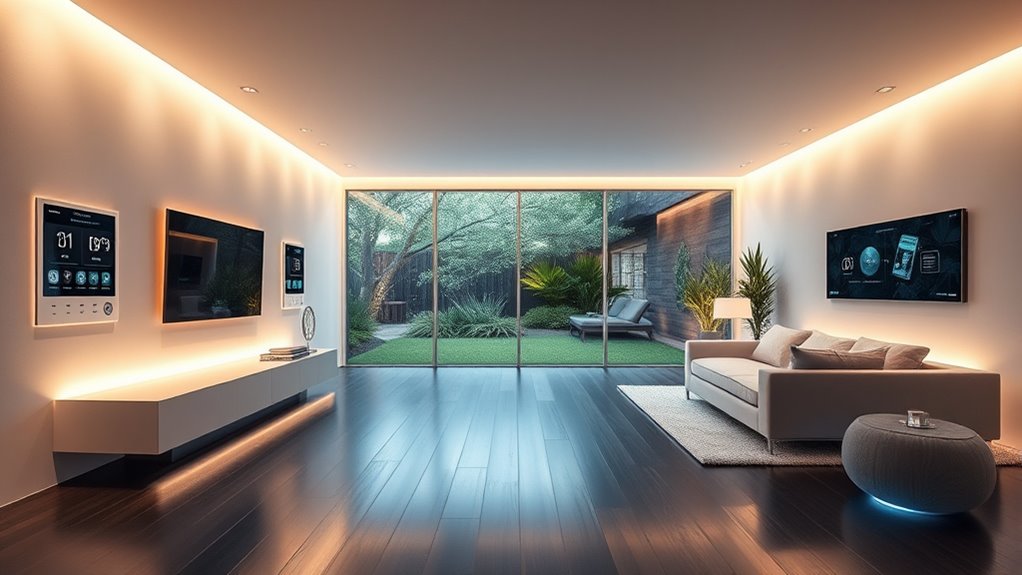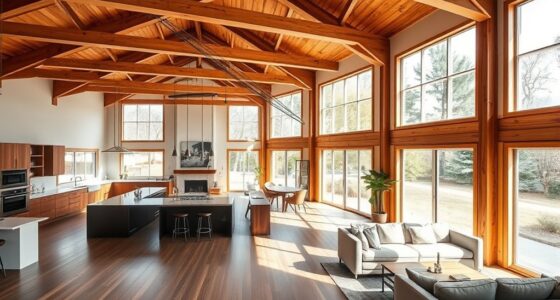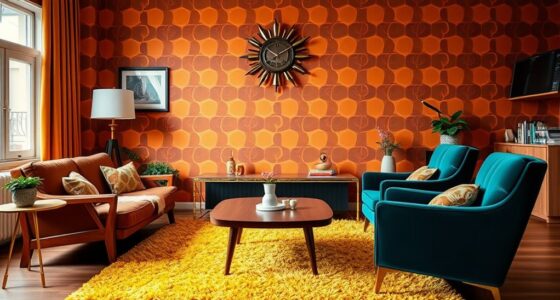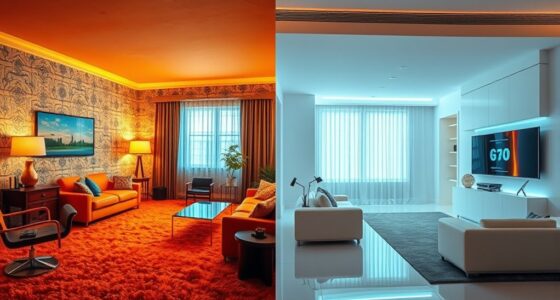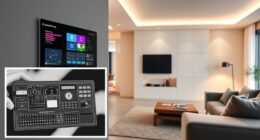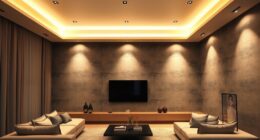In 2005, the “House of the Present” set a new standard in smart home design by blending sustainability, innovative technology, and modern aesthetics. You’ll find homes that prioritize eco-friendly materials, energy efficiency, and integrated automation like smart lighting and climate control. These features not only boost comfort but also promote responsible living. To discover how these principles shaped today’s homes, continue exploring this inspiring approach to modern living.
Key Takeaways
- 2005 marked a shift toward integrated, sustainable home designs combining eco-friendly materials with innovative technology.
- Smart home features like automated lighting and climate control became essential for efficiency and convenience.
- Emphasis on minimalist aesthetics and natural lighting created warm, clutter-free living environments.
- Sustainable architecture prioritized resource efficiency, reducing environmental impact through thoughtful layouts and materials.
- The concept of the “house of the present” reflects balancing modern ingenuity, environmental responsibility, and personal well-being.
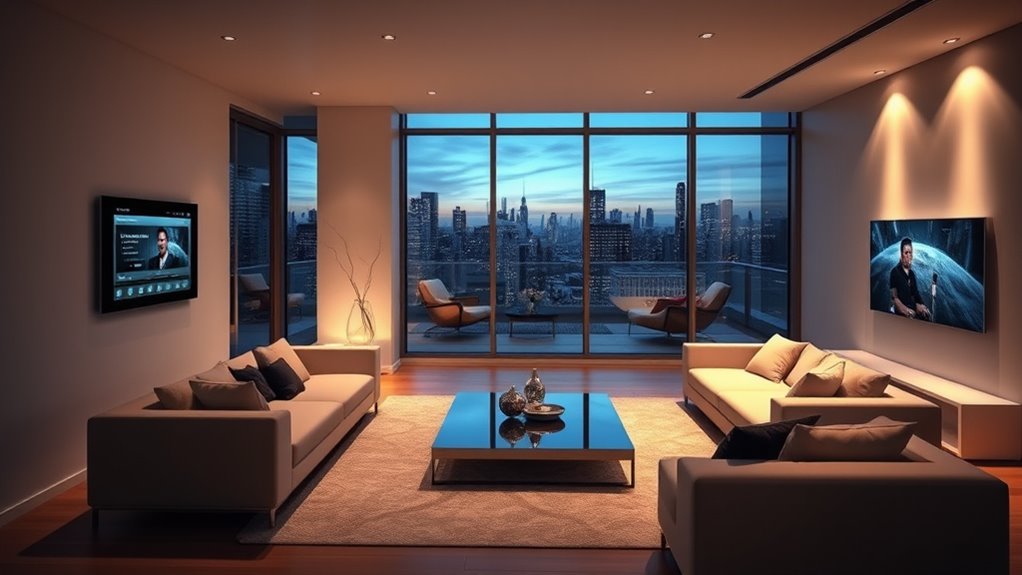
Have you ever stopped to contemplate what the “house of the present” truly represents? It’s not just a place to live; it’s a reflection of how we adapt to our current needs, values, and technological advancements. Back in 2005, the concept of smart home design shifted from mere convenience to a sophisticated integration of sustainability, innovation, and style. This era marked a turning point, emphasizing how a home could be both eco-friendly and seamlessly connected, setting a benchmark for modern living. When you think about the house of the present, it’s impossible to ignore the importance of sustainable architecture. It’s about designing homes that minimize environmental impact while maximizing comfort. Think of materials that are eco-conscious, energy-efficient systems, and thoughtful layouts that reduce waste and resource consumption. These elements are no longer optional but essential in creating homes that serve both their inhabitants and the planet. The 2005 smart home innovations brought this philosophy into mainstream consciousness, blending practicality with responsibility. Modern interior design, at this time, also plays a vital role. It’s not just about aesthetics but about creating spaces that promote well-being and functionality. You’d find minimalist styles that emphasize clean lines, natural light, and eco-friendly materials. The idea is to craft environments that feel warm and inviting without excess clutter or unnecessary ornamentation. These designs focus on versatility, allowing spaces to adapt to different activities and moods. The integration of technology in the house of the present further enhances sustainability and comfort. Automated lighting, climate control, and security systems work in harmony to optimize energy use and reduce waste. This smart technology isn’t just about convenience; it’s about making your home smarter and more responsible. The house of the present also encourages a sense of mindfulness. It’s about creating a space where you’re aware of your environmental footprint while enjoying modern comforts. It’s a balanced approach—combining the best of sustainable architecture with innovative interior design—so that you can live consciously without sacrificing style or convenience. By embracing these principles, you’re not only keeping up with a trend but actively contributing to a more sustainable future. The house of the present isn’t just a concept; it’s a blueprint for how homes can evolve to meet the demands of our time, making your living space an extension of your values and a testament to modern ingenuity.
Frequently Asked Questions
How Has Smart Home Technology Evolved Since 2005?
Since 2005, smart home technology has evolved considerably, making your home more energy-efficient and customizable. You can now easily control lighting, climate, and appliances through intuitive apps or voice commands. Devices learn your habits over time, offering personalized settings that save energy and enhance comfort. The integration of AI and IoT has made your smart home more responsive, seamless, and tailored to your lifestyle, improving convenience and sustainability.
What Are the Future Trends in Smart Home Design?
You’ll see future smart home designs focus on energy efficiency and user customization. Expect homes to incorporate advanced AI that learns your habits, optimizing energy use and comfort automatically. You’ll also have more control over your environment, customizing lighting, temperature, and security with simple interfaces. Innovations will make homes more sustainable, personalized, and intuitive, ensuring you experience greater convenience and lower energy bills in the years ahead.
How Does Smart Home Security Compare to Traditional Systems?
Smart home security offers advanced features like remote monitoring and automation, but it also faces cybersecurity threats and privacy concerns. Unlike traditional systems, these connected devices can be vulnerable to hacking, so you need strong passwords and regular updates. You also should be aware of data collection practices to protect your privacy. While smart security provides convenience, staying vigilant is essential to avoid potential risks.
What Are the Environmental Impacts of Smart Home Technology?
Smart home technology impacts the environment mainly through energy conservation and material sustainability. You help reduce energy use by automating systems like lighting and climate control, lowering your carbon footprint. However, manufacturing devices requires materials that may not be sustainably sourced, and e-waste can accumulate. By choosing eco-friendly devices and recycling, you can minimize negative environmental effects while enjoying smarter living.
How Accessible Are Smart Home Features for Disabled Residents?
Smart home features are increasingly accessible for disabled residents, but accessibility barriers still exist. You can benefit from assistive devices like voice-activated controls and motion sensors, which help overcome physical limitations. However, not all systems are fully inclusive, so it’s essential to select smart home solutions designed with accessibility in mind. By prioritizing these features, you ensure a more comfortable and independent living experience.
Conclusion
You see a home that adapts to your needs, a home that learns your habits, a home that connects you seamlessly. The House of the Present embodies innovation, comfort, and sustainability—all at once. It’s a space that empowers you, a space that anticipates you, a space that evolves with you. Embrace the future of living where technology meets humanity, where design meets purpose, where your home becomes a reflection of your life—present, perfect, poised for tomorrow.
